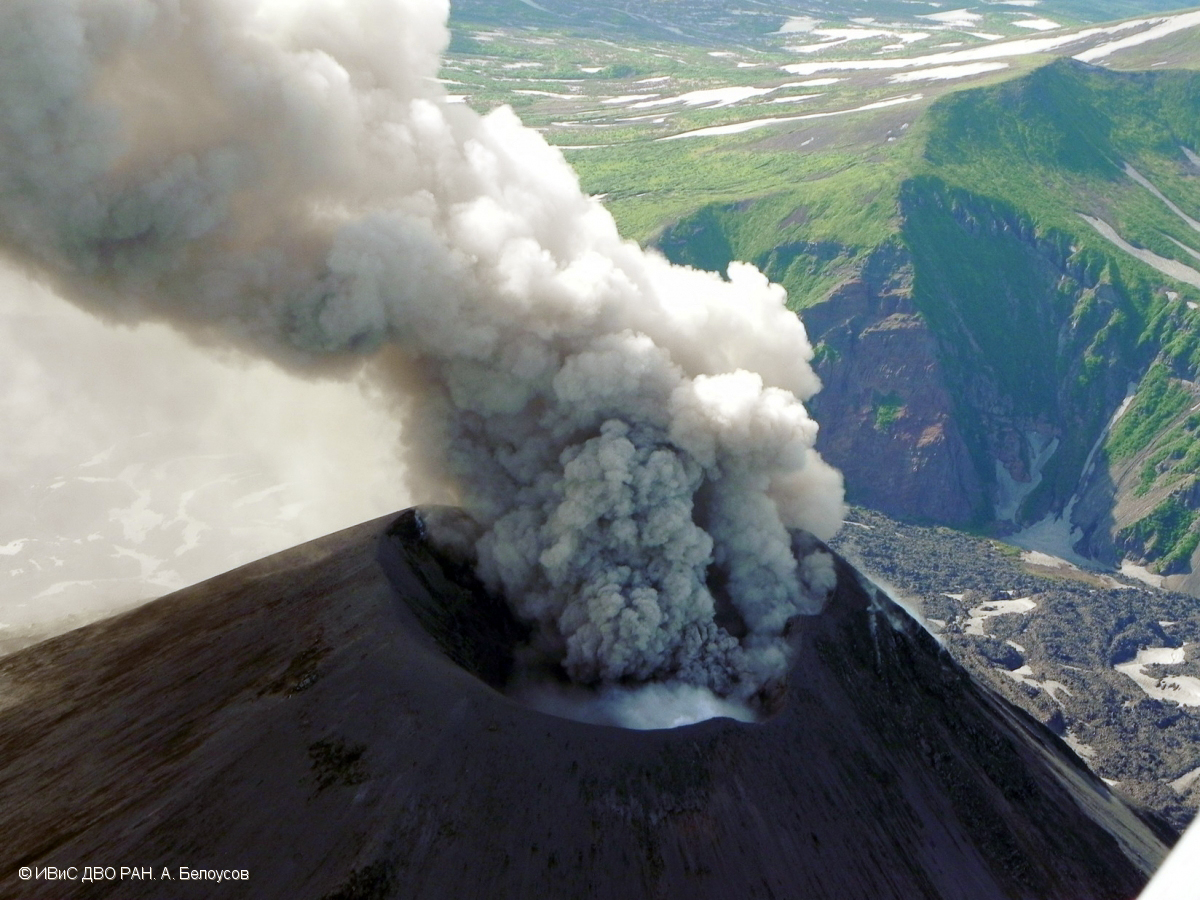Report on Karymsky (Russia) — November 2017
Bulletin of the Global Volcanism Network, vol. 42, no. 11 (November 2017)
Managing Editor: Edward Venzke.
Research and preparation by Paul Berger.
Karymsky (Russia) Moderate ash explosions continue into September 2017
Please cite this report as:
Global Volcanism Program, 2017. Report on Karymsky (Russia) (Venzke, E., ed.). Bulletin of the Global Volcanism Network, 42:11. Smithsonian Institution. https://doi.org/10.5479/si.GVP.BGVN201711-300130
Karymsky
Russia
54.049°N, 159.443°E; summit elev. 1513 m
All times are local (unless otherwise noted)
Recent activity at Karymsky has consisted of ash explosions and thermal anomalies, often separated by several months of quiet (BGVN 40:09 and 42:08). No ash explosions occurred between the middle of October 2016 and the end of May 2017 (BGVN 42:08). This report covers activity from June through November 2017 using information compiled from the Kamchatka Volcanic Eruptions Response Team (KVERT), the Tokyo Volcanic Ash Advisory Center (VAAC), and several sources of satellite data.
After months of quiet, KVERT reported that, based on Tokyo VAAC data, an ash explosion began at 0040 (local time) on 4 June 2017 (table 10). The Aviation Color Code (ACC) was raised from Green (lowest level on a four-color scale) to Orange (the second highest level). Subsequent ash explosions occurred on 8 June, 26 June and 18 July (figure 1).
Table 10. Summary by month of ash plumes and thermal anomalies reported for Karymsky during 2016. Details include UTC dates of thermal anomalies and ash plumes; and maximum plume altitude, and maximum distance of ash plume drift. Sources are KVERT and Tokyo VAAC for ash plume data, and KVERT for thermal data.
| Month | Thermal Anomalies (KVERT) | Date of Ash Plumes | Max Plume Altitude (km) | Max Plume Distance (km) |
| Jun 2017 | 3-8, 10-12, 14-17, 23-24, 27-28 | 3-4, 8, 24, 26 | 6 | 165 |
| Jul 2017 | 1-3. 7, 11-12, 18-20 | 10-11, 18, 20 | 1.7 | 170 |
| Aug 2017 | 1,3,4,6-11 | 3-4, 7-9, 12-13 | -- | 400 |
| Sep 2017 | 1,6, 8, 15-16, 23-25 | 19, 20, 23 | 7 | 100 |
| Oct 2017 | -- | 3, 11-12, 14 | -- | 320 |
| Nov 2017 | -- | -- | -- | -- |
 |
Figure 37. Aerial photo of an ash explosion at Karymsky on 18 July 2017. Courtesy of A. Belousov (IVS FEB RAS). |
Toward the end of August, KVERT noted only gas-and-steam emissions, and the ACC was lowered to Yellow (the second lowest level on a four-color scale) on 30 August. This diminished activity continued until 20 September, when ash explosions at 0420 (local) prompted KVERT to raise the ACC back to Orange.
After 20 September, the volcano was either obscured by clouds or relatively quiet. After 11 October the moderate activity was associated with gas-steam emissions. On 19 October, the ACC was lowered to Yellow and then to Green (lowest level) on 26 October. Gas-and-steam activity continued through the end of November.
Thermal anomalies. Thermal anomalies, based on MODIS satellite instruments analyzed using the MODVOLC algorithm, were not observed at Karymsky during the reporting period, except for a possible hotspot on 8 June 2017 that was slightly E of the craters. The MIROVA system detected at least nine days with low to moderate power hotspots in June, two in July, and one in August, all of which were within 3 km of the volcano. No hotspots were recorded September through November 2017.
Geological Summary. Karymsky, the most active volcano of Kamchatka's eastern volcanic zone, is a symmetrical stratovolcano constructed within a 5-km-wide caldera that formed during the early Holocene. The caldera cuts the south side of the Pleistocene Dvor volcano and is located outside the north margin of the large mid-Pleistocene Polovinka caldera, which contains the smaller Akademia Nauk and Odnoboky calderas. Most seismicity preceding Karymsky eruptions originated beneath Akademia Nauk caldera, located immediately south. The caldera enclosing Karymsky formed about 7600-7700 radiocarbon years ago; construction of the stratovolcano began about 2000 years later. The latest eruptive period began about 500 years ago, following a 2300-year quiescence. Much of the cone is mantled by lava flows less than 200 years old. Historical eruptions have been vulcanian or vulcanian-strombolian with moderate explosive activity and occasional lava flows from the summit crater.
Information Contacts: Kamchatka Volcanic Eruptions Response Team (KVERT), Far Eastern Branch, Russian Academy of Sciences, 9 Piip Blvd., Petropavlovsk-Kamchatsky, 683006, Russia (URL: http://www.kscnet.ru/ivs/kvert/); Institute of Volcanology and Seismology, Far Eastern Branch, Russian Academy of Sciences (IVS FEB RAS), 9 Piip Blvd., Petropavlovsk-Kamchatsky 683006, Russia (URL: http://www.kscnet.ru/ivs/eng/); Tokyo Volcanic Ash Advisory Center (VAAC), 1-3-4 Otemachi, Chiyoda-ku, Tokyo, Japan (URL: http://ds.data.jma.go.jp/svd/vaac/data/); Hawai'i Institute of Geophysics and Planetology (HIGP) - MODVOLC Thermal Alerts System, School of Ocean and Earth Science and Technology (SOEST), Univ. of Hawai'i, 2525 Correa Road, Honolulu, HI 96822, USA (URL: http://modis.higp.hawaii.edu/); MIROVA (Middle InfraRed Observation of Volcanic Activity), a collaborative project between the Universities of Turin and Florence (Italy) supported by the Centre for Volcanic Risk of the Italian Civil Protection Department (URL: http://www.mirovaweb.it/).

